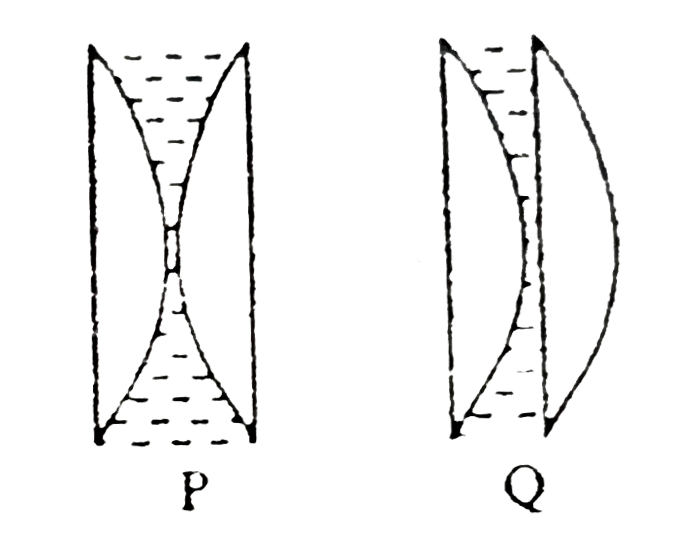A liquid of refractive index is placed between two identical plano-convex lenses, with refractive index . Two possible arrangement P and Q are shown in figure-. The system is:

Divergentin P, convergent in Q
Convergentin P, divergent in 2
Convergent in both
Divergent in both
The correct Answer is:C
Step by step video & image solution for A liquid of refractive index 1.33 is placed between two identical plano-convex lenses, with refractive index 1.50. Two possible arrangement P and Q are shown in figure-. The system is: by Physics experts to help you in doubts & scoring excellent marks in Class 12 exams.
Updated on:21/07/2023Topper's Solved these Questions
- GEOMETRICAL OPTICSBOOK - PHYSICS GALAXY - ASHISH ARORACHAPTER - GEOMETRICAL OPTICSEXERCISE - Numerical MCQs Single Options Correct
51 Videos
- GEOMETRICAL OPTICSBOOK - PHYSICS GALAXY - ASHISH ARORACHAPTER - GEOMETRICAL OPTICSEXERCISE - Advance MCQs with One or More Options Correct
30 Videos
- GEOMETRICAL OPTICSBOOK - PHYSICS GALAXY - ASHISH ARORACHAPTER - GEOMETRICAL OPTICSEXERCISE - Discussion Question
29 Videos
- ELECTROSTATICSBOOK - PHYSICS GALAXY - ASHISH ARORACHAPTER - ELECTROSTATICSEXERCISE - Unsolved Numberical Problems
73 Videos
- HEAT AND THERMAL EXPANSIONBOOK - PHYSICS GALAXY - ASHISH ARORACHAPTER - HEAT AND THERMAL EXPANSIONEXERCISE - UNSOLVED NUMRICAL PROBLEMS FOR PREPARATION OF NSEP, INPhO & IPhO
82 Videos
Similar Questions
The adjacent figure shows a thin plano-convex lens of refractive index μ1 and a thin plano-concave lens of refractive index μ2, both having same radius of curvature R of their curved surfaces. The thin lens of refractive index μ3 has radius of curvature R of both its surfaces. This lens is so placed in between the plano-convex and plano-concave lenses that the plane surfaces are parallel to each other.
The focal length of the combination is

View SolutionCurved surfaces of a plano-convex lens of refractive index μ1 and a plano-concave lens of refractive index μ2 have equal radius of curvature as shown in figure. Find the ratio of radius of curvature to the focal length of the combined lenses.

View Solution
Knowledge Check
A liquid of refractive index 1.33 is placed between two identical plano-convex lenses, with refractive index 1.50. Two possible arrangement P and Q are shown. The system is
 Adivergent in P, convergent in QBconvergent in P, divergent in QCconvergent in both.Ddivergent in both.
Adivergent in P, convergent in QBconvergent in P, divergent in QCconvergent in both.Ddivergent in both.A liquid of refractive index 1.33 is placed between two identical plano-convex lenses, with refractive index 1.50. Two possible arrangement P and Q are shown in figure-. The system is:
 ADivergent in P, Convergent in QBConvergent in P, Divergent in QCConvergent in bothDDivergent in both
ADivergent in P, Convergent in QBConvergent in P, Divergent in QCConvergent in bothDDivergent in bothA liquid of refractive index 1.6 is introduced between two identical plano-convex lenses in two ways P and Q as shown. If the lens ma terial has refractive index 1.5, the combina tion is
 Aconvergent in bothBdivergent in bothCconvergent in Q onlyDconvergent in P only
Aconvergent in bothBdivergent in bothCconvergent in Q onlyDconvergent in P only
A glass lens of refractive index 1.5 is placed in a trough of liquid. What must be the refractive index of the liquid in order to mark the lens disappear?
View SolutionA plano-convex lens is made of refractive index of 1.6. The focal length of the lens is
View SolutionTwo identical thin planoconvex lenses of refractive index n are silvered, one on the plane side and other on the convex side. The ratio of their for lengths is
View SolutionA plano-convex lens has refractive index 1.6 and radius of curvature 60 cm. What is the focal length of the lens?
View SolutionA liquid of refractive index 1.6 is contained in the cavity of a glass specimen of refractive index 1.5 as shown in figure. If each of the curve surface has a radius of curvature of 0.20m, the arrangement obehaves as a

View Solution
